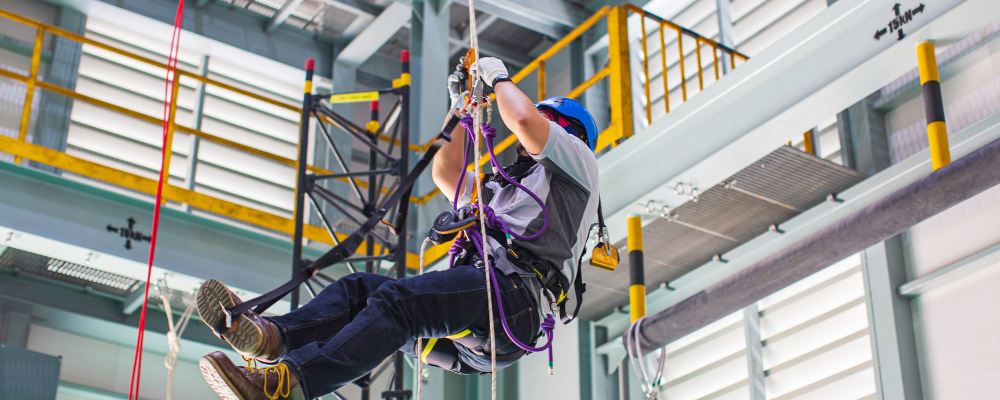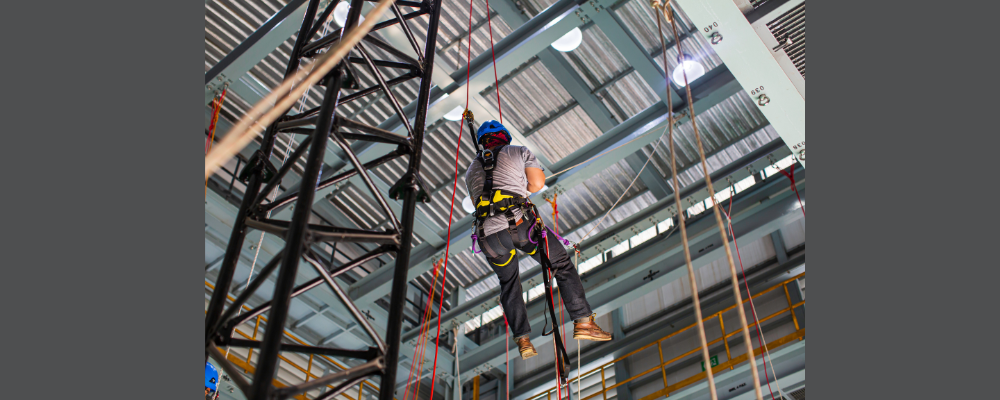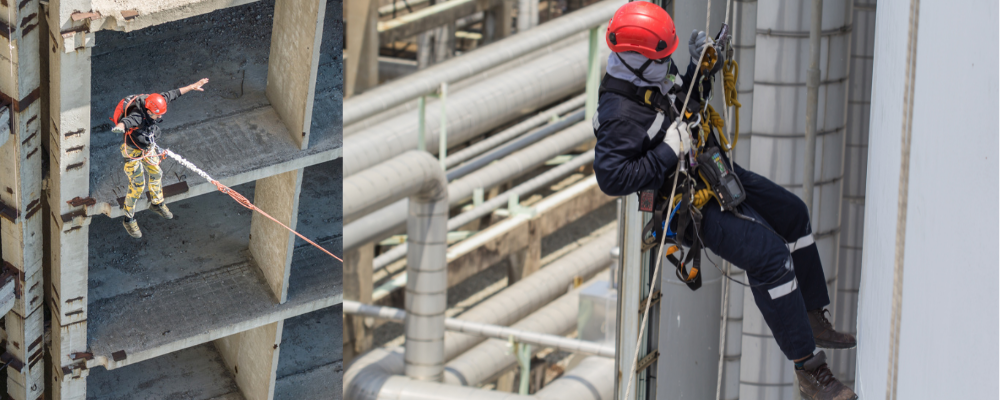
Introduction
Welcome to Site and Safety Solutions, where we prioritize the safety of construction workers. In this comprehensive guide, we will delve into the crucial topic of Fall Prevention in Construction, shedding light on technical details, products, and best practices to keep construction workers safe at great heights. From harnesses to connectors, we’ve covered you with the most reliable solutions for a safer work environment.
Fall Prevention in Construction: Understanding the Risks
Construction work often involves working at considerable heights, making fall prevention a paramount concern. Construction workers face significant risks, and understanding these risks is the first step towards preventing accidents.
The Role of Personal Fall Protection Equipment
Personal Fall Protection Equipment (PFPE) plays a critical role in ensuring the safety of construction workers. At Site and Safety Solutions, we offer a range of PFPE, including:
-
MSA Workman PFLs
The MSA Workman Personal Fall Limiter (PFL) is designed to provide workers with maximum freedom of movement while ensuring their safety. Its cutting-edge technology instantly locks in case of a fall, minimizing the risk of injury.
-
HOOK TWIN SRD STEEL CONNECTOR
Our HOOK TWIN SRD STEEL CONNECTOR is a reliable choice for fall prevention. This durable connector ensures a secure anchor point, giving workers peace of mind while performing their tasks.
-
6′ CABLE CROSSOVER RING / RING 1/4″ VINYL COATED CABLE
Our 6′ CABLE CROSSOVER RING with 1/4″ VINYL COATED CABLE is an excellent solution for workers who need to move freely across a job site. It allows for smooth movement while maintaining fall protection.
-
ADJUSTABLE LANYARD 6 FT. BLUE SHOCK ABSORBER, REBAR HOOK
The adjustable lanyard with a 6 ft. BLUE SHOCK ABSORBER and REBAR HOOK provide added safety during work at heights. It’s designed to minimize the force of impact, protecting workers from potential injuries.
-
ANCHOR STRAP 10FT CROSS ARM FALL PROTECTION
Our 10ft ANCHOR STRAP CROSS ARM provides a secure anchoring point for fall protection systems. It is a key component in preventing falls and ensuring the safety of construction workers.

Proper Harness Selection and Usage
In addition to connectors and lanyards, a reliable harness is essential for fall prevention. At Site and Safety Solutions, we offer the following harness options:
HARNESS 5PT., GROMMET LEGS, PADDED BACK, BACK/SIDE D-RINGS
Our 5-point HARNESS with grommet legs padded back, and back/side D-rings is designed for maximum comfort and safety. It provides excellent support and easy attachment to other fall protection equipment.
Best Practices for Fall Prevention in Construction
Ensuring fall prevention in construction extends beyond merely having the right equipment; it also involves adhering to a set of best practices that are critical in maintaining a safe work environment for construction workers. Here, we outline some key guidelines for these best practices:
Regular Equipment Inspection
Periodic inspection and maintenance of fall protection equipment are vital to ensure its effectiveness. While our products at Site and Safety Solutions are designed with durability in mind, conducting routine checks and maintenance is essential. This practice ensures that the equipment remains in optimal working condition and minimizes the risk of equipment failure during a critical moment.
Regular equipment inspections should include the following aspects:
- Visual Inspection: Inspect all components for visible damage, wear and tear, or deformation. Look for any signs of stress, corrosion, or other forms of degradation. Pay special attention to harnesses, connectors, lanyards, and anchor points.
- Functionality Test: Ensure that all mechanisms, such as retractable lanyards or connectors, work correctly. Test them to verify that they lock and release as intended.
- Webbing and Straps: Examine the integrity of the webbing, straps, and stitching. Any fraying, cuts, or abrasions should be addressed promptly.
- Hardware Inspection: Check all hardware components, such as carabiners, D-rings, and buckles, for defects or malfunctions.
- Shock Absorbers: If your equipment includes shock absorbers, inspect them for signs of deployment or damage. Any shock-absorbing material that has been activated should be replaced.
- Label and Documentation: Ensure all labels, tags, and instructional documentation are legible and current. Any missing or damaged titles should be replaced.
Proper Training
Providing comprehensive training to construction workers on the correct usage of fall protection equipment is non-negotiable. Proper training is the cornerstone of fall prevention, equipping workers with the knowledge and skills to use safety equipment effectively. Here are the essential elements of practical training:
- Equipment Familiarization: Workers should be trained on their specific fall protection equipment. It includes understanding how to don and doff harnesses properly, connect to anchor points, and use lanyards and connectors.
- Safe Practices: Training should emphasize safe working procedures when working at heights. Workers should be educated on how to set up fall protection systems, maintain a secure anchor point, and safely move about the worksite while harnessed.
- Emergency Response: Workers should be trained on what to do during a fall. It includes understanding the importance of self-rescue techniques or, when necessary, how to await rescue from others.
- Regular Refresher Training: Training should not be a one-time event. Regular refresher training sessions should be conducted to reinforce best practices and update workers on any changes in equipment or safety procedures.
Fall Arrest Plans
Developing fall arrest plans specific to the construction site is essential for comprehensive fall prevention. These plans should be tailored to each worksite’s unique characteristics and hazards. A well-structured fall arrest plan should include the following elements:
- Risk Assessment: Identify potential fall hazards at the worksite and assess their severity. Consider factors such as working height, surface conditions, and proximity to unprotected edges.
- Selection of Appropriate Equipment: Based on the risk assessment, select the most suitable fall protection equipment, including harnesses, lanyards, anchors, and connectors.
- Establishment of Safe Working Procedures: Outline step-by-step procedures for safe work practices when working at heights. It should cover adequately setting up fall protection systems, securing anchor points, and navigating the worksite.
- Rescue Plan: Develop a rescue plan that details the steps to be taken in case of a fall. Ensure that all workers know this plan and how to execute it effectively.
- Training and Awareness: Ensure that all workers are educated about the fall arrest plan and receive training specific to their roles in its implementation.
By adhering to these best practices for fall prevention in construction, you can significantly reduce the risks associated with working at heights and create a safer environment for your construction workers. Site and Safety Solutions is committed to providing high-quality equipment and the knowledge and resources necessary to prioritize worker safety.
Fall Prevention Training: Empowering Construction Workers for Safety
At Site and Safety Solutions, we understand that safety in construction hinges not only on the quality of equipment but also on the knowledge and competence of the workers. In this blog, we will explore the critical topic of Fall Prevention Training in Construction, emphasizing its technical aspects and formal training methods designed to empower construction workers to work safely at heights.
Fall Prevention Training: A Necessity in Construction
The construction industry involves inherent risks; one of the most significant risks is falling from heights. Fall prevention training is the linchpin in mitigating these risks and ensuring the safety of workers.
The Importance of Comprehensive Fall Prevention Training
A comprehensive fall prevention training program goes beyond the basics. It equips workers with the knowledge and skills to identify, prevent, and respond to fall hazards.
Understanding Fall Hazards
Practical fall prevention training begins with understanding the various fall hazards present at construction sites. Topics covered may include:
- Edge protection and guardrails
- Floor openings and holes
- Scaffolding safety
- Ladder safety
- Proper use of fall protection equipment
Hands-on training with Fall Protection Equipment
Site and Safety Solutions provides hands-on training in properly using fall protection equipment, including harnesses, connectors, and lanyards. Workers learn how to inspect, don, and use this equipment effectively.
Developing Rescue Plans
A well-executed rescue plan can distinguish between life and death in a fall. Fall prevention training includes developing and practicing rescue procedures and ensuring workers respond promptly and effectively in emergencies.
Identifying and Using Appropriate Anchorage Points
Properly selecting and using anchorage points are crucial for fall prevention. Training covers how to identify suitable anchor points and how to connect fall protection equipment safely.
The Role of Formal Certifications
Formal certifications in fall prevention are essential for construction workers. These certifications demonstrate a worker’s competence and knowledge in fall prevention, making them a valuable asset on any job site.
OSHA Fall Protection Certification
The Occupational Safety and Health Administration (OSHA) provides a comprehensive fall protection certification program. This certification is highly regarded in the industry and is often required by employers.
Competent Person Training
Becoming competent in fall prevention is a significant milestone for construction workers. It signifies a higher level of expertise and responsibility in ensuring safety at job sites.
For more information, visit our website and Facebook page.
For more products, visit our website :
6′ CABLE CROSSOVER RING / RING 1/4″ VINYL COATED CABLE
ADJUSTABLE LANYARD 6 FT. BLUE SHOCK ABSORBER, REBAR HOOK
ANCHOR STRAP 10FT CROSS ARM FALL PROTECTION
HARNESS 5PT., GROMMET LEGS, PADDED BACK, BACK/SIDE D-RINGS
Conclusion
In conclusion, fall prevention in construction is a matter of utmost importance. Site and Safety Solutions is committed to providing high-quality, technical, and formal fall protection equipment to ensure the safety of construction workers. Understanding the risks, using the right equipment, and following best practices can mitigate the dangers of working at heights. Your safety is our priority, and we’re here to support you every step of the way.
We have the products and expertise to keep construction workers safe, whether it’s MSA Workman PFLs, steel connectors, lanyards, anchor straps, or harnesses. Explore our range of fall protection equipment today and make your worksite safer.










